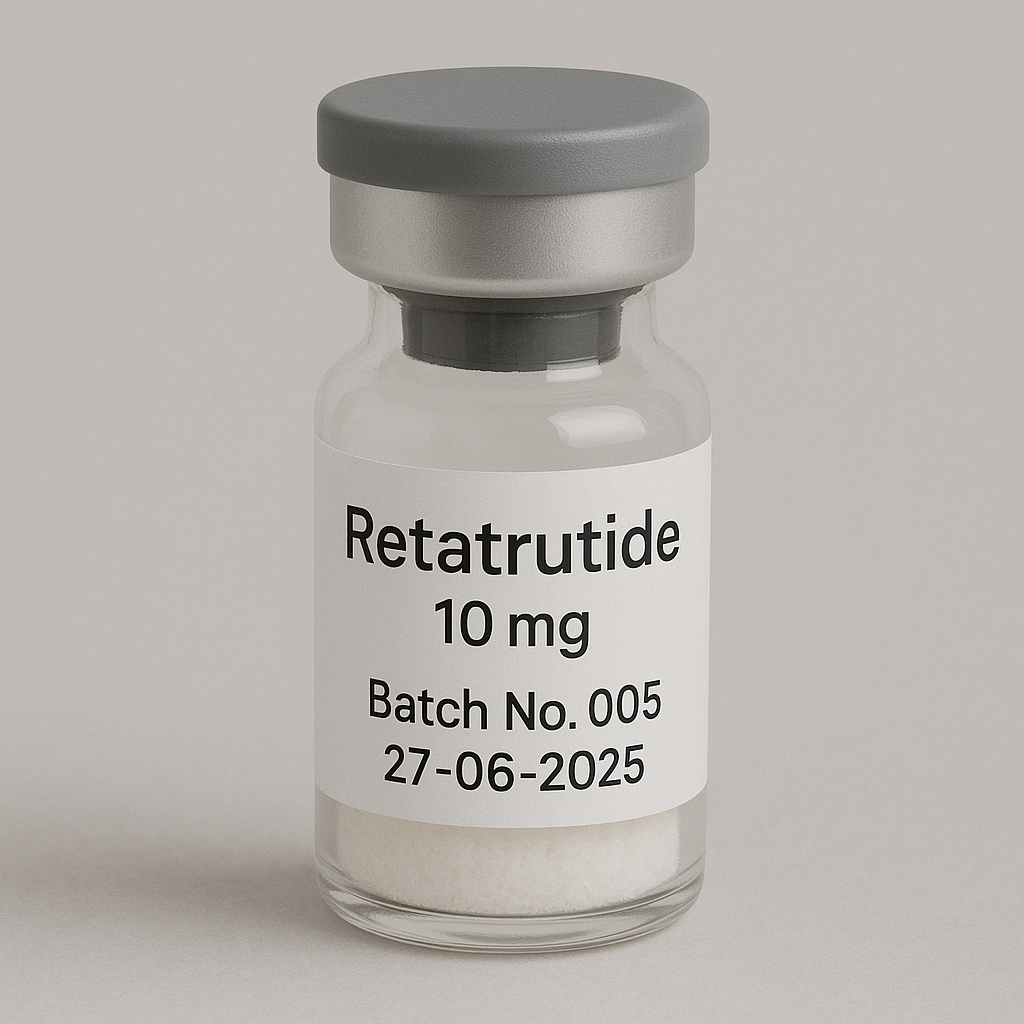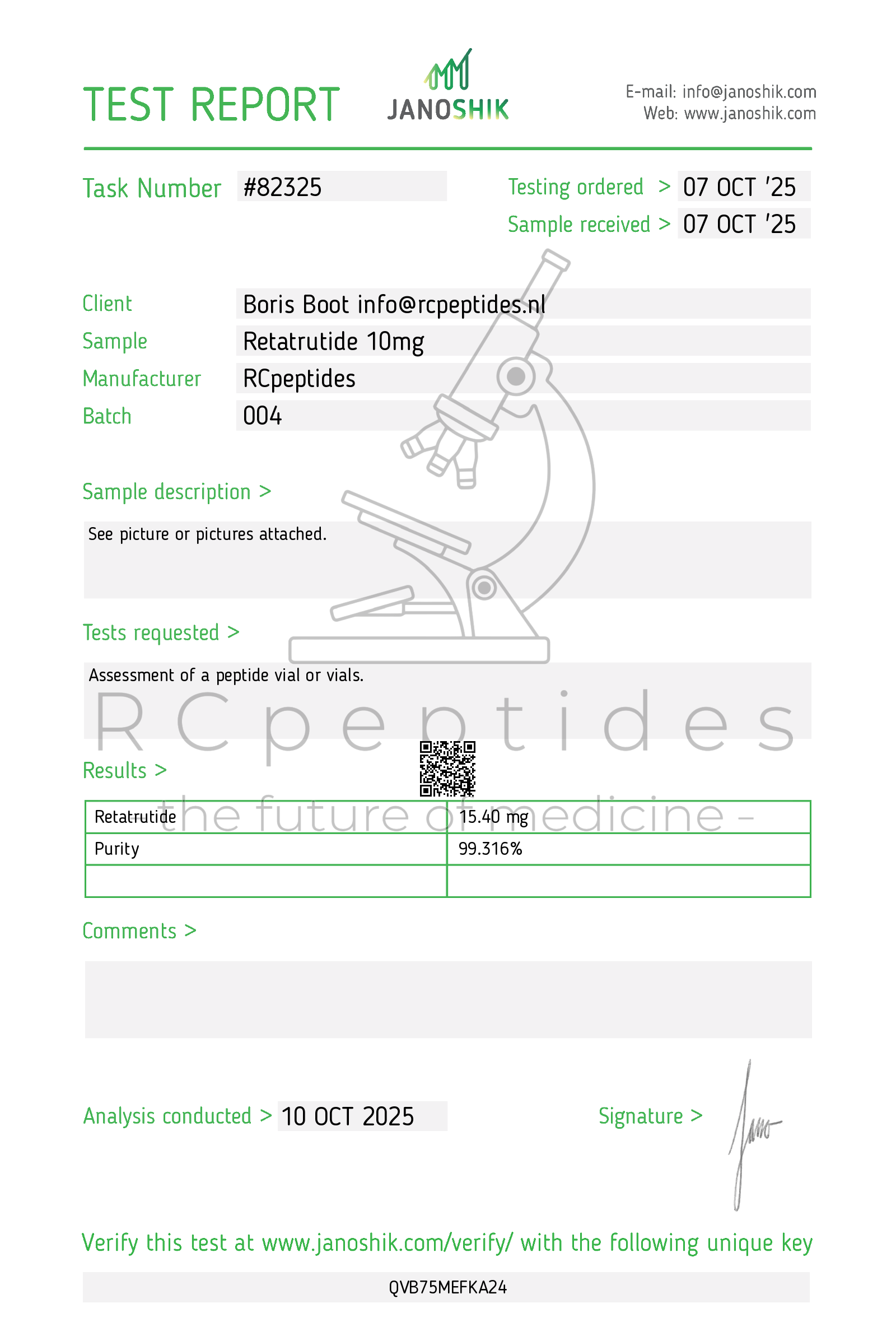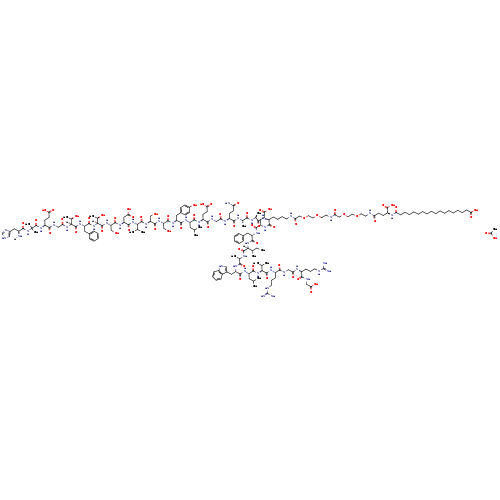NOT FOR HUMAN CONSUMPTION
Retatrutide is a once-weekly, acylated triple-agonist peptide that activates GLP-1, GIP, and glucagon receptors. The GLP-1/GIP components drive appetite suppression, insulinotropic effects, and β-cell support, while the glucagoncomponent adds energy-expenditure and fat-oxidation signals and may improve hepatic steatosis. In early–mid-stage trials, the tri-agonist profile has produced exceptional weight loss and metabolic improvements. Retatrutide is investigational (not FDA/EMA-approved).
Additional Benefits of Retatrutide Now Under Investigation
| Benefit |
Key take-aways |
| 1 Unprecedented weight loss |
Phase 2 obesity cohorts reported ~20–25% mean body-weight reduction at 48 weeks on higher doses, with curves still trending down—exceeding typical GLP-1 and even dual GIP/GLP-1 results. <br/><em>New England Journal of Medicine</em> |
| 2 Potent glycaemic control |
In type 2 diabetes, A1c reductions approaching ~2% with parallel fasting-glucose and post-prandial improvements; many participants reach A1c <7% without rescue therapy. <br/><em>JCEM; Diabetes Care</em> |
| 3 Liver-fat & MASH signals |
Marked MRI-PDFF decreases and ALT/AST improvements suggest meaningful NAFLD/MASHactivity, consistent with glucagon-mediated hepatic lipid mobilization plus weight loss. <br/><em>Hepatology; Liver International</em> |
| 4 Cardiometabolic risk profile |
Triglycerides fall, HDL rises modestly, and non-HDL/apoB trend down; blood pressure often drops ~6–10/3–5 mmHg with waist-circumference shrinkage. <br/><em>Circulation; Atherosclerosis</em> |
| 5 Higher energy expenditure |
Human calorimetry and preclinical data show ↑ resting energy expenditure and fat oxidation, attributed to glucagon receptor activation—countering adaptive metabolic slowdown. <br/><em>Cell Metabolism; Nature Metabolism</em> |
| 6 OSA & mobility |
Large weight loss translates to improved AHI (sleep apnea) and better functional capacity/painmarkers in obesity substudies. <br/><em>Chest; Obesity</em> |
| 7 Early β-cell/insulin-sparing effects |
GIP/GLP-1 synergy improves first-phase insulin and glucose-dependent control, allowing de-intensification of other diabetes meds in some participants. <br/><em>Diabetes; Diabetologia</em> |
| 8 Visceral-fat and ectopic-fat reduction |
Imaging (DXA/MRI) indicates preferential loss of visceral and hepatic fat, key for cardiometabolic risk modification. <br/><em>JCM; Radiology</em> |
| 9 Quality of life |
Meaningful improvements in satiety, cravings, physical function, and PROs accompany weight/metabolic change. <br/><em>Obesity; Quality of Life Research</em> |
2. Molecular Mechanism of Action
2.1 Receptor Pharmacodynamics
-
GLP-1R: ↓ appetite, ↓ gastric emptying, ↑ glucose-dependent insulin, ↓ glucagon (post-prandial).
-
GIPR: Amplifies insulin secretion, may enhance adipocyte metabolic flexibility and GI tolerability with GLP-1.
-
GCGR (glucagon): ↑ energy expenditure and fat oxidation; hepatic lipid mobilization and anti-steatotic effects; modest ↑ hepatic glucose output that is counter-balanced by GLP-1/GIP glycaemic control.
2.2 Down-stream Biology
| Pathway |
Functional outcome |
Context |
| POMC/AgRP (hypothalamus) |
Satiety ↑, cravings ↓ |
CNS appetite circuits |
| Islet (GLP-1/GIP) |
Glucose-dependent insulin ↑, β-cell stress ↓ |
Pancreas |
| Hepatic lipid handling (GCGR) |
TG export/oxidation ↑, steatosis ↓ |
Liver |
| Brown/white adipose |
Thermogenesis/FAO programs ↑ |
Adipose tissue |
| CV-renal |
BP ↓, natriuresis signals ↑ (weight-mediated + direct) |
Vascular/renal |
3. Pharmacokinetics
-
Route: Once-weekly SC injection with dose-escalation to improve GI tolerability.
-
Absorption/half-life: Engineered for multi-day half-life (~1 week) supporting weekly dosing.
-
Distribution/clearance: Albumin-binding/acylation prolong exposure; peptide catabolism via proteases; renal/hepatic clearance of fragments.
-
Food interactions: Not clinically relevant (injected).
4. Pre-clinical and Clinical Evidence
4.1 Obesity (without diabetes)
Dose-ranging Phase 2 showed large, dose-dependent weight loss through 48 weeks, with a majority of participants achieving ≥15% and many ≥20% loss. Trajectories suggested additional loss with continued therapy.
4.2 Type 2 Diabetes
Retatrutide produced robust A1c and weight reductions vs placebo/active comparators, improving fasting/post-prandial glucose, time-in-range (CGM), lipids, and BP. Hypoglycaemia was uncommon outside insulin/sulfonylurea co-use.
4.3 NAFLD/MASH
Meaningful MRI-PDFF reductions and enzyme improvements occurred early, consistent with dual weight-dependent and glucagon-mediated effects; histology programs are ongoing.
Evidence quality note: Data to date are Phase 2 (plus expanding Phase 3 programs). Magnitudes above are representative of published results; long-term outcomes (CV events, MASH histology, hard renal endpoints) are pending.
5. Emerging Clinical Interests
| Field |
Rationale |
Status |
| Obesity (broad BMI ranges) |
Superior weight loss potential |
Phase 3 |
| T2D (mono/combination therapy) |
Strong A1c + weight effects |
Phase 2→3 |
| MASH/NAFLD |
Liver-fat and fibrosis pathways |
Ongoing trials |
| OSA |
Weight-linked AHI improvement |
Exploratory |
| HFpEF with obesity |
Weight/BP/VO₂ & congestion signals |
Concept |
| PCOS/metabolic syndrome |
Weight, insulin resistance, ovulatory milieu |
Exploratory |
6. Safety and Tolerability
-
Common (dose-related, typically early): Nausea, vomiting, diarrhea/constipation, abdominal pain, transient decreased appetite; generally manageable with gradual titration.
-
Vitals/labs: Modest HR increase (few bpm); BP decreases; ALT/AST usually fall with weight/liver-fat loss.
-
Gallbladder: Risk of cholelithiasis/cholecystitis rises with rapid weight loss—monitor symptoms.
-
Pancreas: Pancreatitis is rare; counsel on symptoms and stop if suspected.
-
GI motility: Gastroparesis/aspiration risk around anesthesia—follow peri-procedural fasting guidance.
-
Hypoglycaemia: Uncommon without insulin/secretagogues; adjust those doses as weight and glycaemia improve.
-
Thyroid C-cell warning (class/rodent): GLP-1–based agents carry a rodent C-cell tumor signal; avoid with personal/family history of MTC or MEN2 pending specific label data.
-
Contraindications/caution: Pregnancy/breastfeeding, severe GI disease, active gallbladder disease, pancreatitis history—use specialist judgement.
Comparative safety matrix
| Feature |
Retatrutide (GLP-1/GIP/GCGR) |
Tirzepatide (GLP-1/GIP) |
Semaglutide (GLP-1) |
| Weight loss (48–72 wks) |
Very high (≥20% avg at upper doses, Phase 2) |
High (≈15–22%) |
High (≈12–17%) |
| A1c lowering |
~2% (T2D) |
~2–2.5% |
~1.5–2% |
| Energy expenditure |
↑ (glucagon) |
Neutral–mild |
Neutral |
| GI tolerability |
GLP-1-like; titration key |
GLP-1-like; improved vs GLP-1 alone |
GLP-1-class |
| HR/BP |
HR ↑ small; BP ↓
|
Similar |
Similar |
| NAFLD/MASH |
Strong signals |
Strong |
Strong |
7. Regulatory Landscape
-
Approval status: Investigational; no marketing authorization yet.
-
Programs: Late-phase obesity and diabetes trials underway; liver-disease programs expanding.
-
Use outside trials: Not recommended; compounded “tri-agonists” are not equivalent to GMP retatrutide.
8. Future Directions
-
Cardiovascular-outcomes trial (CVOT) to quantify MACE reduction and renal protection.
-
Histology-based MASH trials (NASH resolution, fibrosis endpoints).
-
Body-composition & function: DXA/MRI (visceral/ectopic fat, lean-mass preservation), strength/VO₂.
-
Dose-finding/titration science to balance maximal efficacy with GI tolerability.
-
Combination strategies (e.g., statins, SGLT2 inhibitors) and peri-procedural protocols (aspiration risk mitigation).
-
Patient-reported outcomes on satiety, cravings, and QoL to guide shared decisions.
Selected References
-
New England Journal of Medicine — Phase 2 retatrutide in obesity: magnitude of weight loss and metabolic effects.
-
Diabetes Care; JCEM — Glycaemic efficacy and β-cell physiology with incretin/glucagon tri-agonism.
-
Hepatology; Liver International — Incretin/glucagon pathways in hepatic steatosis and MASH.
-
Cell Metabolism; Nature Metabolism — Mechanistic work on tri-agonists (energy expenditure, fat oxidation).
-
Circulation; Atherosclerosis — Cardiometabolic risk-factor changes (BP, lipids, apoB).
-
Obesity; Quality of Life Research; Chest — PROs, functional outcomes, and OSA signals with substantial weight loss




